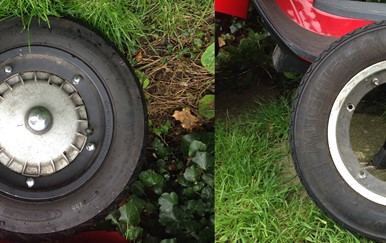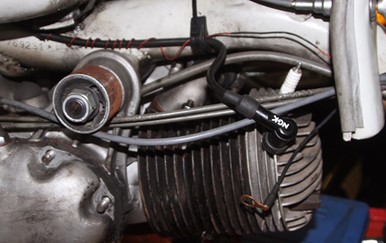How big are yours?
Size does count and you ideally need to know how big your tyres are before buying them. It may sound simple, but unless you’re dealing with a scooter shop that know what you want when asking “I want two tyres for a Vespa P-range please?” you are likely to be questioned about their dimensions.
If you’re renewing the rubber on a 60s to PX era geared Vespa or Lambretta then you will probably be looking at 3.00x10 or 3.50x10.
There are of course a few 8” wheeled Vespas that continued into the 70s as well as the older 50s models of both to consider, and then you also have the obscurities of the early Vespa small frames and J range Lambrettas, so it’s always best to check in your handbook or ask a reputable dealer before parting with your cash.
You should find the size of your current tyre marked on its sidewall, but if you don’t know the scooter’s history, there is always a chance that it may not be correct. There are also modern equivalents of old sized tyres, and Sticky’s Lambretta manual offers comparison for both Lambretta and Vespa riders.
Treads, patterns and compounds
It might sound ideal to get a tyre to last for years on end, especially if you are a high mileage rider, but you get nothing in life for free. Cheaper tyres tend to have a compound so hard they take ages to wear down, meaning they will take longer to warm up and therefore have less grip compared to one with a softer compound.
Different treads cope with different terrains differently; tyres with few grooves and very rounded profiles are often referred to as semi-slick as these are derived from completely smooth racing tyres. A good semi-slick tyre will be manufactured from a soft-ish compound which heats up quickly and sticks to the road pretty well, which together with the profile, will allow for faster riding and cornering.
On the negative side it won’t do well in the rain and will wear out far more quickly. On the other hand, a poor-quality semi-slick may look the part, but the compound will be hard, and you’ll end up coming off if you try to ride like Barry Sheene.
Aquaplaning is what can happen when riding in the rain as your tyres cannot disperse the water beneath them fast enough and they start to float rather than grip the road. Tyres with a greater amount of intricate grooves are usually designed for maximum water dispersion, the idea being to keep as much rubber in contact with the road as possible.
Again, a poorly designed tyre may look pretty, but is less likely to work effectively. The reality is that big tyre companies spend a lot money, time and effort into getting tyres to work properly, so you want to be buying them according to your riding needs and not just because you think they look nice or will last forever.
Classic style
There are plenty of modern-day options that use a classic style tread pattern, allowing your old scooter to retain its looks but without compromising its safety. For that reason, my advice is don’t buy New Old Stock tyres. It’s likely their structure will not have aged well and whatever claims a seller may make about the storage over the last 40 years or so, if they were meant to even last that long, Pirelli, Ceat and Michelin would still have a manufacturer’s warranty on them. Which they don’t. So, don’t be tempted, unless your scooter is a museum piece, never to turn a wheel on a road again.
Writing on the wall
The numbers and wording on the side of the tyre contain a whole heap of information. There’s the manufacturer’s name and brand, a reference number relating to where and when it was manufactured and whether it’s for tubed or tubeless tyres (tubeless tyres can be used with tubes in, but tubed tyres cannot be run tubeless).
The tyre size will also be shown, along with load and speed rating. You need to check these with the retailer before purchasing to make sure its suitable for your particular scooter. Note that any specific model can have a number of versions with different ratings depending on what scooter it was designed for. There should also be an ‘E’ marked stating it is approved for use on European roads - if not, walk away.
The final word
Whether you are braking or accelerating, corning or straight lining, popping out for a pint of milk or touring around Europe, there are only ever two small patches of tyre that are in contact with the road. No matter who built your engine, how nice your clothes are, or what theme your custom paintjob is based around, the tyres are the most important part of your scooter so choose them wisely, don’t forget to check them regularly and maintain them well. We’ve put together a list of 5 essential scooter maintenance tasks to make this easy and ensure your two-wheeler stays on the road and in as best condition as possible.









